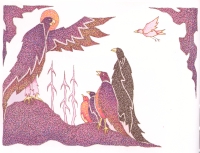| ________________
CM . . .
. Volume IX Number 19 . . . . May 23, 2003
excerpt:
This pourquoi tale employs the narrative device of a contemporary Algonquin grandmother telling her young grandson, Heyden, a story about how, as the title indicates, the eagle came to have its white head. Had Chartrand, the author, wished, she could have added “and how the hummingbird got its ruby throat” to the title for the story is almost more about the little bird than it is about the larger one. According to Nokomis, when the world was just new, the Creator chose the Eagle to be the leader of the birds and the Bear to be the in charge of all the land creatures. However, the world became overpopulated, and Bear suggested that Eagle visit the Creator to seek a solution. When Eagle tells the birds of his intention to visit the Creator and seeks their advice on what to say, all but Hummer [the hummingbird] offer very self-centered and selfish responses. Because Eagle is away on his arduous journey for many seasons, the birds, again with just the exception of the hummingbird, decide to select a new leader. However, Hummer takes a final flight to see if he can see Eagle and does finally spot him. The Creator takes all of the animals and birds to a new land, but before doing so, the Creator rewards Eagle for his suffering and not quitting by giving him the distinctive white head by which he is recognized today. And to Hummer, “for being faithful, loyal and brave,” the Creator “placed a shining ruby” on Hummer’s throat. As the traditional story is used as a teaching, Nokomis tells Heyden how he shares Hummer’s qualities. In addition to an Algonquin prayer, the book concludes with a statement of the symbolic role of both the eagle and the hummingbird to Native peoples. With the exception of the first two illustrations, the stylized art of Algonquin artist Tsun captures the nature aspect of the story. Although How the Eagle Got His White Head contains excellent content worthy of sharing during storytime, the book’s small size (16 cm x 16 cm) will make it difficult for the illustrations to be readily seen. Highly Recommended. Dave Jenkinson teaches courses in children’s and adolescent literature at the Faculty of Education, the University of Manitoba.
To comment
on this title or this review, send mail to cm@umanitoba.ca.
Copyright © the Manitoba Library Association. Reproduction for personal
use is permitted only if this copyright notice is maintained. Any
other reproduction is prohibited without permission.
NEXT REVIEW |TABLE OF CONTENTS FOR THIS ISSUE - May 23, 2003. AUTHORS | TITLES | MEDIA REVIEWS | PROFILES | BACK ISSUES | SEARCH | CMARCHIVE | HOME |

